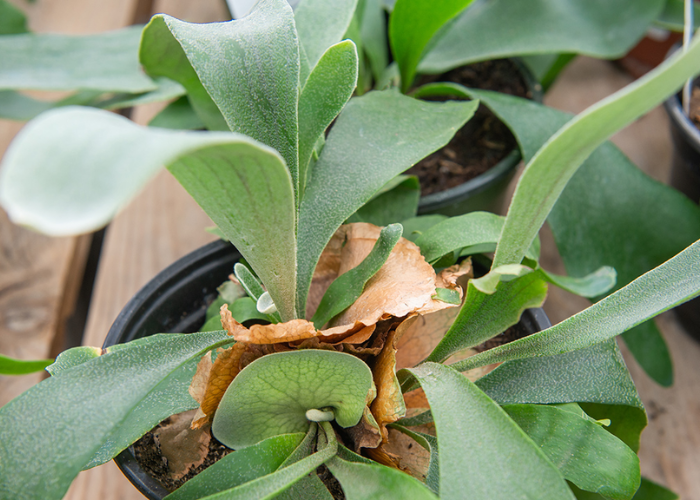When it comes to houseplants, the staghorn fern is one of the most interesting specimens. With its unique antlers-like appearance, this fern can bring a unique touch to any home. Despite its beauty, however, it is highly sensitive to overwatering and can be easily damaged if not properly cared for.
What is a Staghorn Fern?
A Staghorn Fern is a type of epiphyte, which is a plant that grows on another plant or object, without taking nutrients from it. It is native to the tropical and subtropical regions of the Americas, Africa, Asia, and Australia.
Staghorn Ferns are characterized by their antler-like fronds, which are divided into long, narrow, triangular segments. They typically grow in the crooks of trees and can be found in natural habitats such as rainforests, woodlands, and swamps.
These plants are popular houseplants, as they are relatively easy to care for and require minimal maintenance. Although Staghorn Ferns are fairly tolerant to drought, they can suffer from overwatering, which can cause root rot and other issues.
To avoid overwatering, it is important to water the plant when the soil is dry and to ensure that it is planted in a well-draining potting mix.
Causes of Overwatering in Staghorn Ferns
Staghorn ferns are unique and beautiful plants that require careful monitoring and maintenance to keep them healthy. One of the most common problems that can affect these plants is overwatering.
This is due to the fact that staghorn ferns are native to tropical and subtropical climates, which naturally receive more water than dryer climates. Overwatering can cause a range of issues, such as root rot, leaf discoloration, and decreased growth rate.
While overwatering can affect all types of plants, it is particularly dangerous for staghorn ferns, as they are especially sensitive to excess moisture. To avoid these issues, it is important to ensure that the soil remains moist, but not soggy and that the plant is not exposed to standing water. As with any plant, it is important to water your staghorn ferns deeply, but sparingly.
Symptoms of Overwatering in Staghorn Ferns
When it comes to the symptoms of overwatering in Staghorn Ferns, it is important to note that they are often very similar to the symptoms of underwatering. This is because both can cause the plant to become stressed and weak.
The most common symptom of overwatering in Staghorn Ferns is yellowing foliage. The leaves may also become limp, and wilted, and start to turn brown. The roots of the plant may turn black, indicating that the plant is unable to absorb enough water.
Additionally, the soil may become water-logged, and the plant may also become more susceptible to fungal infections. All of these symptoms are signs that the plant is suffering from overwatering and should be addressed as soon as possible.
How to Identify if a Staghorn Fern is Overwatered
Identifying whether a staghorn fern is overwatered can be tricky. While a healthy staghorn fern should have firm, bright green fronds, an overwatered fern will have wilted fronds that may even turn yellow or brown.
Furthermore, an overwatered fern may also start to rot, with its fronds becoming slimy and soft. Additionally, you may find black or brown spots on the fronds of an overwatered fern, which are signs of fungal infections.
Finally, if your fern has been overwatered for a significant amount of time, you may even see root rot, as the roots of the plant will become black and slimy. All of these signs should be alerting you to the fact that your fern is receiving too much water.
Solutions for Overwatering in Staghorn Ferns
When it comes to overwatering in Staghorn Ferns, the best solution is to make sure that you give them the right amount of water. That means not over-watering them, but also not under-watering them.
To do this, you should water your Staghorn Ferns when the top couple of inches of soil feel dry. When you water them, it’s important to use lukewarm water and pour it over the root ball until it starts to drain out of the bottom of the pot.
You may need to adjust the frequency of watering depending on the season. During the summer, you may need to water more often, whereas, in the winter, you can water less.
Additionally, you should make sure to use a pot with drainage holes to prevent the soil from staying too wet. If your Staghorn Fern is already overwatered, you can try to let it dry out.
Take it out of the pot and let it sit in a sunny spot until the soil is dry to the touch. If the damage is more serious, you may need to report the fern in a pot with fresh soil.
Prevention of Overwatering in Staghorn Ferns
Preventing overwatering in staghorn ferns is an important aspect of their care. These plants are tropical, so they require higher humidity than other plants. To create the proper moisture levels in the soil, it is important to use a well-draining soil mix that is rich in organic matter.
Additionally, it is important to avoid over-watering the plant, as it is susceptible to root rot. A good rule of thumb is to wait until the top two inches of soil is dry before watering your plant. It is also important to ensure that the pot has adequate drainage holes, so any excess water can escape.
Finally, misting your staghorn fern will help boost its humidity, so it is recommended that you give it a light misting once or twice a week. Following these simple steps will help keep your staghorn fern healthy and thriving!
Conclusion
Overwatered Staghorn Fern is a plant that can be difficult to keep alive, but with proper care and attention, a healthy and beautiful Staghorn Fern can be enjoyed in your home. It is important to be mindful of the amount of water you are giving your Staghorn Fern, as too much water can lead to root rot, fungal infections, and other problems.
Make sure to monitor the amount of water you give your Staghorn Fern, and make sure to check for signs of overwatering such as yellowing leaves, stunted growth, and wilting. If at any point you suspect that your Staghorn Fern is receiving too much water, take action immediately by reducing the amount of water you give it and allowing the soil to dry out between waterings. With proper care and attention, a healthy and thriving Staghorn Fern can be enjoyed in your home.






